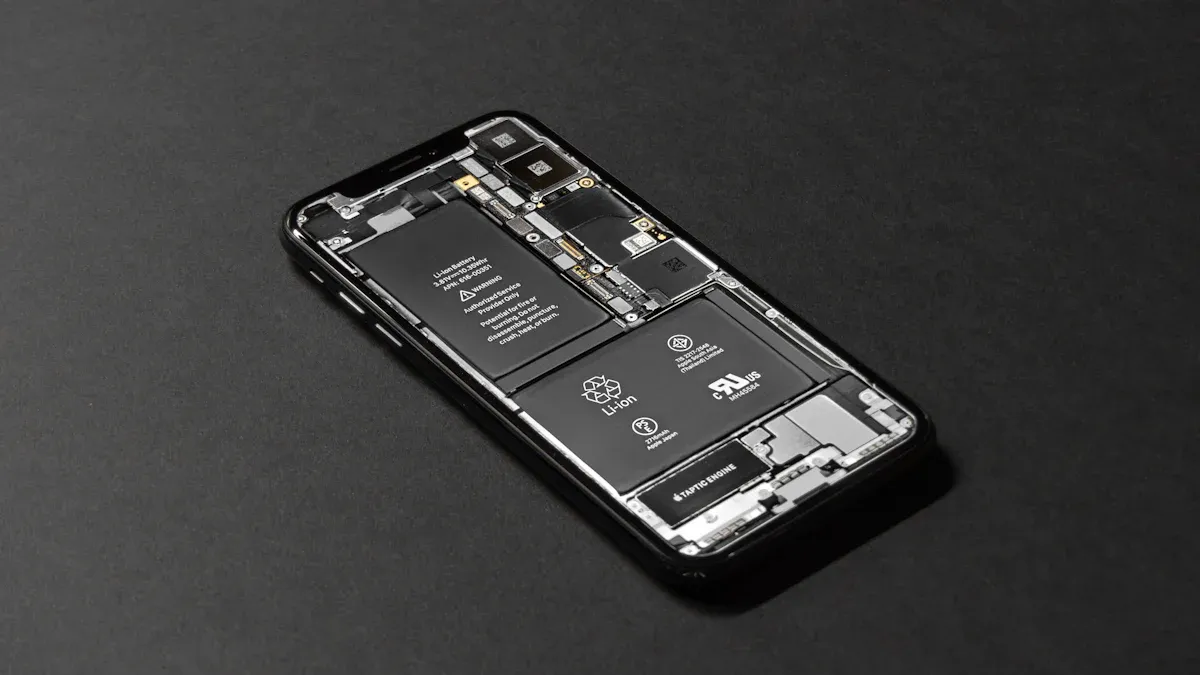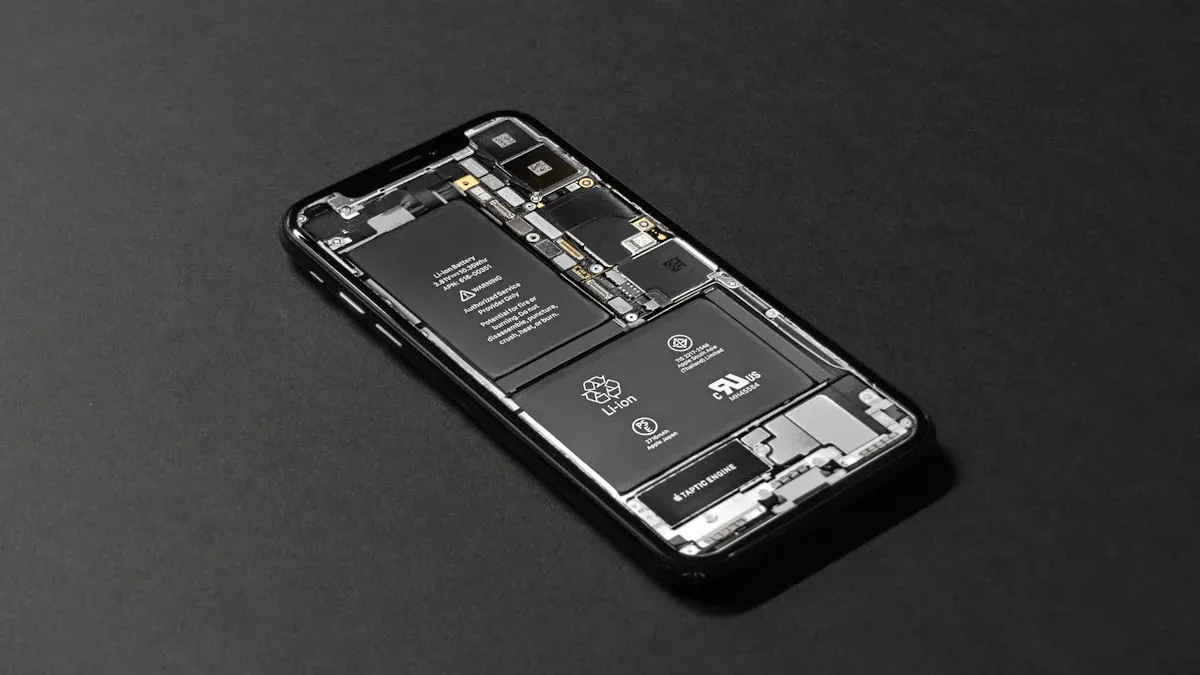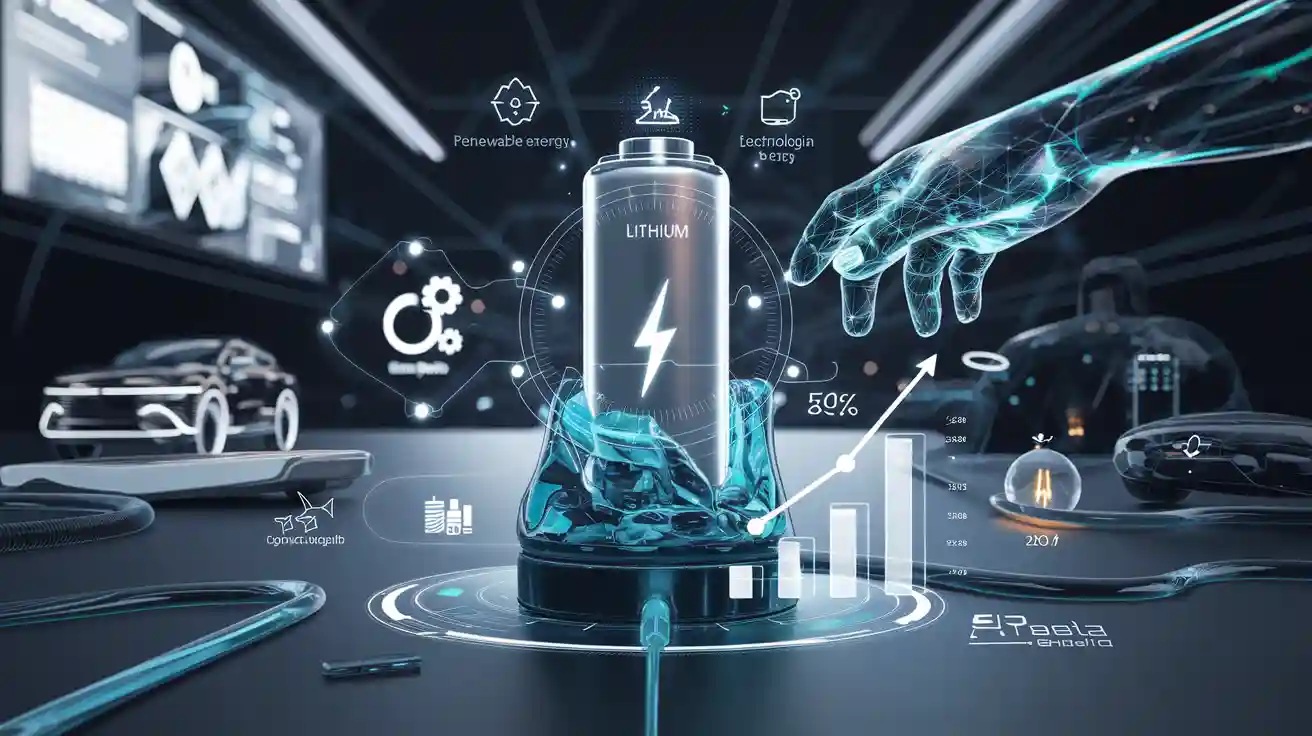New Opportunities for Lithium Batterie
You are in the middle of a big change in energy. Lithium batteries help many industries move forward.
Lithium batteries power electric vehicles. They help keep grids steady. They let you use cleaner energy each day. Their small size and easy care make them useful and good for the environment.
| Metric | Value |
|---|---|
| Base year market size | $109.9 billion |
| Market size forecast | $221.7 billion |
| Growth rate | CAGR of 13.5% for 2024-2029 |
| EV sales in 2023 | Nearly 14 million |
| Global battery production in 2023 | 2.5 TWh |
New opportunities arise as more people want electric vehicles, better electronics, and ways to store renewable energy. You watch lithium technologies change fast. They bring safer and greener choices.
Key Takeaways
- Lithium batteries are very important for electric cars and storing renewable energy. The market will grow from $109.9 billion in 2023 to $221.7 billion by 2029.
- New technologies like solid-state batteries and better recycling help make batteries safer. They also increase how much energy batteries can hold. These changes help make battery production better for the environment.
- Fast-charging technology lets devices and electric cars charge quickly. This makes them easier to use every day.
- Government rules and programs help people use more lithium batteries. This creates new jobs and helps support cleaner energy.
- Lower battery prices and new technology make lithium batteries easier to get. This helps more people use them in many things, like electronics and healthcare.
New Opportunities in Lithium Batteries
Market Growth
Every year, there are more chances in the battery market. More people want lithium batteries now. This is because electric vehicles, renewable energy storage, and better electronics are popular. You can look at the numbers to see how fast things change:
- The global lithium-ion battery market was $109.9 billion in 2023.
- Experts think it will reach $221.7 billion by 2029, with a CAGR of 13.5%.
- Some say the market could be $182.5 billion by 2030.
- From 2023 to 2032, the market may grow from $53.95 billion to $179.65 billion, with a CAGR of 14.3%.
Asia-Pacific is growing the fastest. China and Japan sell the most electric vehicles. India and Indonesia also help the market grow, with a 15.2% CAGR. North America and Europe have new chances too. In North America, new technology and clean energy rules help the market. In Europe, Germany and France want zero CO2 emissions by 2050. This goal makes more people use lithium batteries.
There is also a big change from lead-acid batteries to lithium batteries. This brings many good things:
- Lithium batteries have higher energy density, so devices work longer.
- They last longer than lead-acid batteries, so you replace them less.
- Lithium batteries are better for the environment, which helps with sustainability.
Now, many people pick lithium batteries for cars and energy storage. There are more chances as companies stop using old battery types.
Emerging Technologies
You can find new chances in the latest battery technologies. These new ideas help make batteries safer, last longer, and work better. Here are some important new technologies:
- Solid-State Batteries: These use a solid electrolyte, not a liquid. They have higher energy density and are safer. Solid-state batteries lower fire risk and last longer.
- Recycling and Sustainability: New recycling ways help reuse battery materials. This cuts down waste and helps the environment.
- Integration with Smart Grids: Now, batteries can connect to smart grids. This lets you manage energy in real time and use power better.
- Customization and Scalability: Factories can make batteries that fit what you need. You can get batteries for cars, homes, or big power plants.
There are also new battery types like blade batteries and solid-state batteries. These are safer and last longer. Here is a table to compare traditional lithium-ion batteries, blade batteries, and solid-state batteries:
| Feature | Traditional Lithium-Ion Batteries | Blade Batteries | Solid-State Batteries |
|---|---|---|---|
| Performance | High energy density | Similar energy density, better thermal performance | Highest energy density, improved safety |
| Safety Features | Risk of overheating and fire | Enhanced thermal management, lower fire risk | Lower fire risk, high thermal stability |
| Lifespan | 2,000–5,000 charge cycles | Over 5,000 charge cycles | Potentially longer, still developing |
| Environmental Impact | Contains cobalt, harmful mining | Better material management, improved recycling | Lower impact, easier recycling |
| Cost Considerations | Lower price, mass production | Prices dropping as tech matures | Higher cost, scaling challenges |
Blade batteries and solid-state batteries give new chances for safer and better energy storage. These new ideas help you use batteries in more ways and places.
Innovations in Lithium-Ion Batteries

Energy Density
Lithium-ion batteries can now store more energy. New materials help batteries hold extra power in small spaces. Your devices last longer. Electric vehicles can go farther.
- Solid-state batteries have higher energy density. They use solid electrolytes. This packs in more energy and makes batteries safer.
- Silicon anodes are starting to replace graphite. Silicon stores more lithium. Batteries charge faster and run longer.
- Lithium iron phosphate (LFP) cathodes are better now. These cathodes help electric vehicles work well and last longer.
Here is a table that shows how new methods help energy density:
| Improvement Method | Material Used | Benefit |
|---|---|---|
| Surface Modification | ZnO | Helps lithium move in and lowers volume change |
| Alloy Formation | Lithium Silicon Alloy | Makes anode materials last longer |
You get these benefits when you use your phone, drive an electric car, or store solar energy at home.
Safety
Safety is important for lithium-ion batteries. New features help stop fires and explosions. Battery makers use materials that do not burn. They add controls to keep batteries cool. These changes lower risks and keep you safe.
| Safety Feature | Description |
|---|---|
| Non-combustible Materials | Lower fire risk and make batteries more stable |
| Active Thermal Risk Control | Watches temperature and stops overheating |
| Proactive Fire Suppression | Stops problems from too much current or voltage |
| Improved Fire Safety Standards | Tests with real fires help design safer batteries |
Tip: Always use batteries and chargers that are certified to stay safe.
Fast Charging
You want your devices and cars to charge fast. Fast-charging technology helps make this happen. Engineers use new ways to speed up charging.
| Charging Method | Description |
|---|---|
| Pulse Charging | Sends energy in steps for quick and safe charging |
| Reflex Charging | Uses charging and resting cycles to protect batteries |
| Smart Charging | Changes charging current to keep battery life strong |
| Megawatt Flash Charging | Uses high voltage for super-fast charging |
- Megawatt flash charging can add energy for two kilometers in one second.
- You can add hundreds of kilometers in just a few minutes.
Fast charging makes batteries hotter. This can cause chemical reactions and make batteries age faster. Charging quickly may lower how many times you can use your battery. Engineers try to balance charging speed and battery life for best results.
Solid-State
Solid-state batteries change how you use energy. These batteries use solid electrolytes instead of liquids. You get more energy, better safety, and longer battery life. The market for solid-state batteries is growing quickly. It was worth $85 million and could reach $963 million by the end of the decade. Electric vehicles and energy storage help this growth.
| Aspect | Details |
|---|---|
| Current Market Value | $85 million |
| Projected Market Value | $963 million by decade's end |
| Anticipated Growth Rate | Nearly ten times bigger |
| Key Drivers | Demand in EVs and energy storage |
| Challenges | Picking materials, cell resistance, safety checks |
ProLogium made the first GEN 4 solid-state lithium ceramic battery platform. This platform makes batteries easier to build and lowers costs. ProLogium is building a big factory in Dunkirk, France, to make more batteries.
Solid-state batteries still have problems. Making them is hard and scaling up is tough. Solid electrolytes can break easily and do not move heat well. Dendrite growth from lithium-metal electrodes can cause short circuits. Engineers are working to fix these issues so you can use solid-state batteries in more devices.
Note: Solid-state batteries promise safer and longer-lasting energy, but you may need to wait for mass adoption as technology gets better.
Applications of Lithium Batteries

Electric Vehicles
Lithium batteries are changing how electric vehicles work. Most electric vehicles today use these batteries. In 2024, they make up over 65% of the market. You get more energy in a small space. The batteries last longer and charge quickly.
- New battery chemistry lets cars go up to 3,000 miles on one charge.
- Fast-charging batteries fill up in just minutes.
- Energy-dense batteries help you drive farther without worry.
You can drive longer and wait less to charge your car. These changes make electric vehicles easier to use every day.
Energy Storage
Lithium batteries are important for storing energy. You use them to save power from solar panels and wind turbines. They work well and do not lose much power over time.
- Save extra energy from the sun or wind.
- Help balance changes in how much energy is made.
- Give quick power to keep the grid working.
| Advantage | Description |
|---|---|
| High Energy Density | Hold more energy in a small space. |
| Efficiency | Keep energy steady when going in and out. |
| Longer Lifespan | Work for thousands of cycles, good for changing energy. |
| Scalability | Can be used in homes or big solar farms. |
You see lithium batteries taking the place of old battery types. They are faster to set up and cost less now. More people use renewable energy, so the market for energy storage is growing.
Consumer Electronics
Lithium batteries power your phones, laptops, tablets, cameras, and wearables. You get long battery life and small size. These batteries store lots of energy in tiny spaces. This makes your devices lighter and easy to carry.
- Most mobile devices use lithium batteries because they hold a lot of energy.
- You can use your device longer and charge it faster.
Healthcare
You need lithium batteries for portable medical devices. These batteries make equipment lighter and easier to move.
- High energy density keeps devices small and easy to carry.
- Long life means you do not need to replace them often.
- Fast charging makes sure devices are ready to use.
- Steady power keeps patients safe who need life-support.
Defense
Lithium batteries help new military technology. You find them in combat gear, submarines, drones, and space vehicles.
- High voltage means fewer batteries are needed.
- They last 10–15 years, which saves money.
- Light batteries help soldiers carry less weight.
- Strong power helps with military tools and radios.
- They need little care and are safe for tough places.
You see lithium batteries helping many areas, like cars, hospitals, and defense.
Market Drivers for Batteries
Policy
Government rules help shape lithium battery use. Many countries give money to help people pick cleaner energy. These rules help move to renewable energy and make grids stronger. When governments spend on lithium batteries, they make new jobs. New industries start to grow. People get better ways to store energy and backup power. These changes help you use energy in smarter ways.
Sustainability
Sustainability is important for energy storage and lithium batteries. Companies try to lower harm to the environment. You see new plans that protect nature and help people. Here is a table that shows how the industry works to be more sustainable:
| Initiative | Description |
|---|---|
| Sustainable Mining Practices | Use mining methods that protect nature and animals. |
| Improved Battery Recycling | Make recycling better to cut waste and save materials. |
| Ethical Sourcing | Get raw materials in fair ways and respect workers and communities. |
| Renewable Energy Transition | Use renewable energy in factories to lower carbon emissions. |
You see more recycling and better ways to get materials. These actions help you support cleaner energy.
Cost
Lower prices help more people buy lithium batteries. Battery prices are dropping quickly. This makes electric vehicles and energy storage cheaper.
- Electric vehicles use most batteries now, about 70-80% of demand.
- Battery pack prices dropped from over $1,000 per kilowatt-hour in 2010 to about $138 per kilowatt-hour in 2023.
- Lower prices help electric vehicles cost the same as regular cars, so more people want them.
You get cheaper batteries and more choices for storing energy.
Supply Chain
Supply chain problems change how you get lithium batteries. Companies have trouble getting materials, making batteries, and moving them.
- Getting materials needs lithium, cobalt, and nickel from special places.
- Making batteries needs new technology for safety and quality.
- Moving batteries costs more and can be slow.
- Recycling has problems with technology and places to do it.
Companies look for new materials and better ways to make batteries. They build stronger local supply chains and try new recycling methods. These changes help make cleaner energy easier to use.
Note: More recycling and global investment are important for meeting future lithium battery needs and helping the energy transition.
Future of Lithium and Batteries
Competition
You see new battery technologies changing how we store energy. Sodium-ion batteries are a new choice. They compete with lithium batteries but have problems.
- Sodium-ion batteries use materials that are easy to find. This helps make the supply chain stronger.
- They do not work as well as lithium batteries. They also cost more.
- Lithium carbonate prices dropped recently. This makes sodium-ion batteries less popular.
- Some companies, like Bedrock Materials, stopped making sodium-ion batteries. They could not keep up with lithium batteries.
You notice companies want better ways to store energy. The market is changing as they look for new solutions. There will be more competition in the future. Lithium batteries still lead because they work well and cost less.
Supply
You see supply chain problems affect energy storage. It is hard to get enough lithium, cobalt, and nickel. These materials come from only a few places. This slows down the move to cleaner energy.
- Mining lithium uses lots of water and chemicals. This can hurt people living nearby.
- Battery makers try to find new sources. They also want to recycle old batteries better.
- Companies want to build local supply chains. This helps meet demand and supports cleaner energy.
You see strong supply chains are important for the future. Recycling and new mining ways help meet what the market needs.
Environment
You learn about problems for nature and people from batteries. Mining and throwing away batteries can cause harm.
- Getting lithium uses much water and bad chemicals. This can hurt land and force people to leave.
- Old batteries can leak chemicals into dirt and water. This pollutes nature.
- Batteries can start fires in landfills. These fires let out bad gases.
- Mining cobalt and other metals cuts down trees and ruins soil.
- Small batteries are thrown away a lot. Their toxic parts can hurt people.
You see we need better recycling and safer ways to throw out batteries. The future depends on protecting nature while giving people the energy they need.
Innovation
You see new ideas change how we store energy. Battery makers work together to make better technology and help the move to cleaner energy.
| Innovation Type | Description |
|---|---|
| Solid-State Batteries | These give more energy, charge faster, and are safer. |
| Lithium-Sulfur Technology | This makes batteries last longer and work better. |
| Sustainable Manufacturing | Companies work together to make batteries cleaner and stronger. |
You see new ideas help the future of energy storage. Recycling and new battery types help meet what people need. You help make a cleaner world by picking better ways to store energy.
You find new chances with lithium batteries all the time. These chances help you use energy in smarter ways. You see chances in electric vehicles, energy storage, and electronics. These chances let you pick safer batteries. You get batteries that last longer. You notice chances for faster charging. These chances support clean energy. They help protect the planet. You see batteries cost less. Recycling gets better with these chances. New jobs are created. Technology moves ahead because of these chances. You use cleaner energy. Storing energy becomes easier. You save money with these chances. You have more options to pick from. These chances help you learn new things. You grow and improve with them. You can build a better future. You ask questions and explore more. You can lead others. You help shape the world. You use these chances to make energy storage smarter and cleaner.
-

 May.2025.11.24Ternary Lithium Battery vs Lithium-ion: Complete Comparison Guide (2025 Edition)Learn More
May.2025.11.24Ternary Lithium Battery vs Lithium-ion: Complete Comparison Guide (2025 Edition)Learn More -

 May.2025.11.214S2P 18650 14.8V Battery: Complete Technical Guide, Specs, Applications & SafetyLearn More
May.2025.11.214S2P 18650 14.8V Battery: Complete Technical Guide, Specs, Applications & SafetyLearn More -

 May.2025.11.18PCM vs BMS in Lithium Batteries: What’s the Difference and Which One Do You Need?Learn More
May.2025.11.18PCM vs BMS in Lithium Batteries: What’s the Difference and Which One Do You Need?Learn More -

 May.2025.11.17Custom Li-ion Battery Design for Medical Devices (2025 Comprehensive Guide)Learn More
May.2025.11.17Custom Li-ion Battery Design for Medical Devices (2025 Comprehensive Guide)Learn More -

 May.2025.11.17The Future of Lithium-Ion Batteries: Innovation, Sustainability, and Global Market TrendsLearn More
May.2025.11.17The Future of Lithium-Ion Batteries: Innovation, Sustainability, and Global Market TrendsLearn More
















